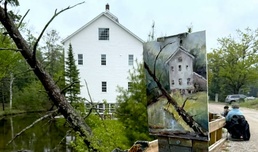Happy Anniversary, COH!
Sept. 2, 2016
 City Opera House Celebrates 125 years
City Opera House Celebrates 125 years Back in the 1800s, you knew a town had grown from mere settlement to a proper city once it acquired its own opera house. In 1892, Traverse City joined the Michigan branch of that elite club. It cost $50,000 — a fortune at the time — to build City Opera House, one of only 48 opera houses in Michigan at the time.
Behind the project were three Traverse City businessmen: Anton Bartak, Frank Votruba, and Charles Wilhelm, who shared a vision of erecting a structure that would bring the community together to celebrate the arts. The COH did exactly as its founders dreamed, hosting plays, concerts, and operettas illuminated by some of the first electric lights installed in town.

What no one foresaw was that Traverse City’s opera house would live on well into the 21st Century. This year, the venerable COH celebrates its 125th anniversary — a feat made even more impressive by the fact that, today, only seven Victorian opera houses remain open in the state.
Although the Grand Old Lady, as the Opera House is nicknamed, retains much of its original grandeur, it’s endured a number of personality changes over the years. In 1920, the building was leased by a motion picture distributor solely so he could eliminate it as competition for his other movie houses in town. In the 1930s, it was briefly part of a Depression-era project the Works Progress Administration had spearheaded to help local folks find employment. And for the 50 years following the W.P.A., it sat mostly dormant, a dusty moth with every light on its stage extinguished. Despite its decades of closure, the COH was designated a Michigan State Historic Site in 1971 and added to the National Register of Historic Places in 1972.
In 1980, a small catalyst prompted some COH momentum: William and Gretchen Votruba donated the shuttered venue to Traverse City. “Bill was part of one of the first families that built the Opera House,” explained Karen Smith, City Opera House Arts Advocate and former chairperson. “But it had become so disused, there was just a little office in there and not much else. Fortunately, the Votrubas had known enough to hang onto it, and they then gifted it to the city for $1.”
The transfer put the COH back on the city’s radar. A group of citizens formed the City Opera House Heritage Association and the City of Traverse City granted the group a 75-year lease of the building. Thus began a long-term plan to restore the venue to its former self, which in its glory days had included a stunning barrel-vault ceiling and fresco paintings with gold-leaf accents.
“The city kind of begrudgingly accepted the Opera House at first,” Smith said with a laugh. “They weren’t really interested in it at all, and it still languished for years after that, as it was tough for people to put their arms around a project that big.”
Smith, who is the longest-standing board member (she’s been on the board since the late ’70s) and has led the COH fundraising efforts, said that to get people excited about renovating it, the association decided to work on the building one chunk at a time, so that the results would become visible more quickly and encourage further work.

Diane Baribeau, City Opera House’s executive director, pointed out that even though the building had finally gotten its proverbial toe into the door of change, it would take the Heritage Association 30 more years of effort to raise the $8.5 million necessary to complete the major renovations.
“It’s been such an unorthodox campaign,” she said. “We’ve combined things like grants and calling local families like the Dows, who were known for donating to projects like this.
Finding funding opportunities through Lansing with the help of people like former Michigan Sen. George McManus, and holding events. But in the end, it was that combination of things that’s made this work, plus we have an absolutely wonderful board to support us.”
To start with, the floor of the stage area had to be completely refinished, and the crossover (the hallway that allows actors to move from one side of the stage to the other side without being seen by the audience) had to be bumped out because people couldn’t fit through it. “Then we built a new entrance,” Baribeau said, “because you used to have to enter the Opera House on a very steep set of stairs. And we also added our ticket booth and offices.”
Bob Spence of Spence Brothers Construction, also a board member, has been involved with City Opera House’s renovations since 2007. “I stepped in just after the first two phases of renovation that took it from completely shuttered, closer to where it is today,” Spence said. “But it’s been a 35- to 40-year process.”
While the long fundraising process certainly slowed the building’s revitalization, the age of the building and decades of neglect played far bigger roles, Spence said. To reveal the venue’s intricate wall stencils, layers and layers of grime had to be peeled back first. Adding to the complications: working with construction from a completely different time period. “When you break into a wall or a floor that’s been there since the 1800s, you never know what you’re going to get,” Spence said. “You have to do a little bit of demolition … see what’s there … and then figure out exactly what you’re going to do next. So it takes a lot of time.” Since COH is now a functioning venue, Spence and his team also have to work around the performance schedule. “We have to be neither seen nor heard,” he said.
“Bob’s put in countless hours,” Smith added. “He loves the place, and he does such great work.”

While the celebrating has been happening since spring, the most recent renovations to COH are nearing completion just in time for the anniversary celebration on Feb. 5, 2017.
“We have completed renovations on the third floor — restrooms and a new community room,” Baribeau said. “We’ll have new dressing rooms on the second floor with backstage access. And we just got approval from the city for a three-sided, cantilevered canopy that will go out front with backlit City Opera House letters — not flashy, but period-appropriate — that we think that will really help people find the venue, as sometimes they walk right by it!” “The canopy will definitely make the building more identifiable,” Spence agreed. “And I’ve seen some vintage photos were there actually was a canopy in the old days, so it will be neat to bring that back. We’ve also improved the second floor lobby area — we added a bar and chandelier and made it more inviting.”
Spence said his favorite
part of working on the building is the historical nature of the project.
“It’s great to watch it be taken back to the way it was when it was a
full-fledged opera house, just getting its start,” he said. “And it’s
exciting that 125 years later, not only is the place open, but we’ve
improved it. Year to year, it keeps getting better!” Smith cites the
venue’s acoustics among her favorite features, although she also
mentioned that new sound equipment is another thing on their renovations
wish list. “Our current system is primarily for spoken word, so
whenever we have a big show, we have to rent equipment in,” she said.
She also loves COH’s half-rounded, barrel-vault ceiling. “It looks like
waves on the lake, especially if you stand on the balcony,” she said.
“Very appropriate for Traverse City!”
Clearly, City Opera House’s idle days have long since passed. The 680-seat venue is a common destination for fans of the arts and cultural happenings, hosting National Writers Series author events, the SwingShift and the Stars dance-off, and portions of the Traverse City Film Festival. In the 2015– 2016 season alone, City Opera House hosted over 60,000 visitors at 260 events.
Additionally, the Opera House has partnered with Michigan State University’s Wharton Center for Performing Arts in order to offer more quality content and outstanding live shows to the community. And it also hosts private functions like weddings, proms, and conferences, all right in downtown Traverse City.
For the Feb. 5 anniversary date, there’s even more on the way — though Baribeau remains mum on the details. “We’re working on a special event for February that will be free to the community,” Baribeau said. “More will be announced on that as we get closer to the date.”
Whatever the anniversary event, supporters of the arts have reason to celebrate COH every day; the space grows more beautiful with each project, and it remains a real center for the community, just as its founders had hoped. “This project for me is a real passion,” Smith said. “The Opera House offers so much for Traverse City and the surrounding area, for us all to come together in such a space. I think it’s amazing that we have this place from 1892, and we’ve gotten it back to the point we have today. It’s a great source of pride. I never get tired of working on it, and I want to help make sure it goes on for another 125 years.”
For more information, visit cityoperahouse.org.
Trending

The Art of Summer: 15+ Exhibits, Fairs, and Workshops in August
Northern Michigan comes alive in the summer, and so does its art scene. From shoreline towns to downtown galleries, creativi… Read More >>
Hill Top’s Mojito Mojo
Midday slump sufferers, rejoice! We’ve found the sweet spot between a cup of coffee and an energy drink (but with none… Read More >>
Dance the Week Away
Traverse City Dance Project is all about using the power of professional dance to “unite, empower, and inspire communi… Read More >>


